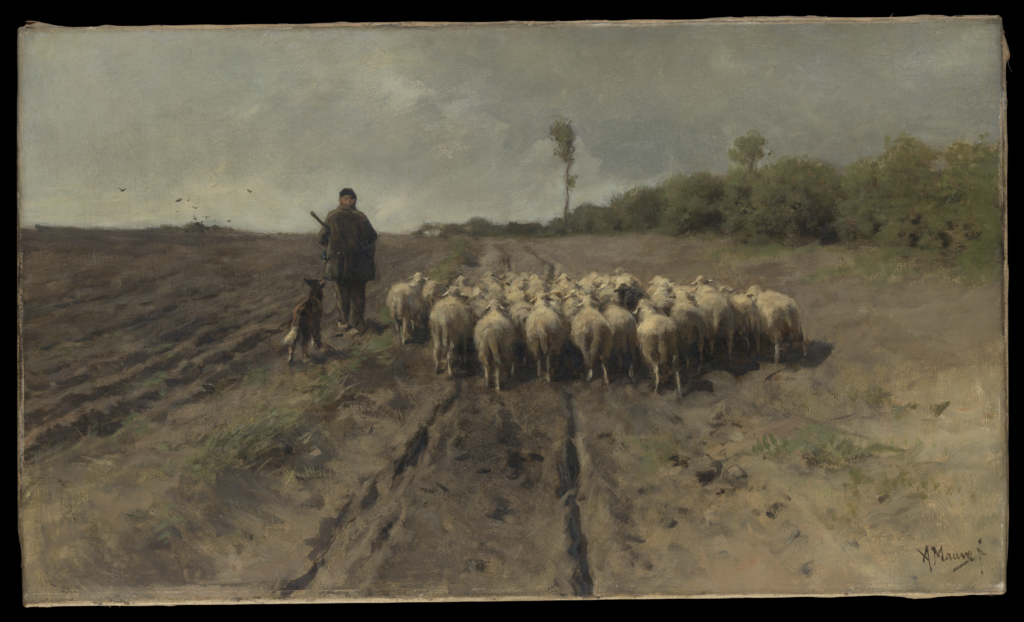
Anton Mauve, The Return to the Fold (1978). Public Domain.
For our series Making of a Poem, we’re asking poets to dissect the poems they’ve published in our pages. Patty Nash’s poem “Metropolitan” appears in the new Summer issue of the Review, no. 248.
Do you have photos of different drafts of this poem?
I do not write in “drafts.” I just continue to write or tinker on the same poem until I can’t anymore. This means that it is hard to see earlier iterations of the poem—the earliest one I have access to is one that I sent to my friends, so it was somewhat presentable already. There are small line differences, however, and sometimes major ones. For example, I changed the gender of the protagonist in this section—here is a screenshot of an earlier version:

I also slimmed down the ending, thank goodness. Earlier version here as well:

How did this poem start for you? Was it with an image, an idea, a phrase, or something else?
At the time, I was writing many ninety-five-item list poems, informed by the myth of the ninety-five theses. An aggrieved monk, Martin Luther, nails his complaints to a church door—then, as the story goes, all hell breaks loose. (Of course, it was a lot more complicated than that.) I was interested in this auratic, definitely apocryphal idea of an earth-shattering text or event. In this case, the “event” represented by the theses was the Reformation. While “reform” sometimes implies social progress, this certainly was not the case for the Reformation, which I understand more as a rearrangement of control, a reorganization of power relations. I used the form of these theses as a mantle for my writing, sheltering the affects of my daily life under this formal mantle of historical grandiosity. It’s sort of silly. But just like everyone else on the planet, I am involved in historical events at all moments.
This particular poem happened after visiting New York City with my boyfriend, Johannes—that’s where the title “Metropolitan” comes from. We were amazed at the extent to which our experience of New York aligned perfectly with our expectations of the city, which had been cultivated through decades of movies, books, and television. If this mythologized idea of visiting a famous museum was a cultural product, we were its consumers. On the other hand, we were its producers, too. The poem’s first line is a quote from my friend Emma, who asked Johannes if he read literature after we were done with the Met. I thought this was a truly amazing question—what is “literature,” anyways?—and let the poem develop from there.
How did writing the first draft feel to you? Did it come easily, or was it difficult to write?
When I was writing this poem, I was having so much fun that I thought it couldn’t possibly be a “real” or “serious” poem. Unlike the other list poems I was writing, this one includes a lot of overheard moments—people at a party, a doctor checking my lungs, people in line at the museum, my friends, me in moments of thoughtlessness, me in the third person, my family members in central Oregon. In a sense, this poem takes on fleeting observation, and listening, as its subject, and I wanted to do so in a way that didn’t feel random. It was important that I still retain the emotional core, the serious interest in smallness.
How did you come up with the title for this poem?
This was difficult. I felt hesitant about situating the poem so explicitly in the Metropolitan Museum of Art, or the Metropolitan Opera, because it felt so hammy. My friend Elijah has said that he categorically hates all poems with New York neighborhood names in them, and I feared that this might go down that route, trying to evoke this mystified, urbane coolness with references. On the other hand, cheesy as it sounds, I was really into New York. This poem was “Untitled” for a while but I then settled on “Metropolitan,” which is what my heart was telling me to do. “Metropolitan” doesn’t just imply New York, but also the concentration of a city, its postured centrality.
Were you thinking of any other poems or works of art while you wrote it?
Certainly! It takes place in the Metropolitan Museum of Art, after all. One of my favorite paintings I saw there, pointed out to me by my boyfriend Johannes, was The Return to the Fold by Anton Mauve, which depicts a flock of sheep retreating from the viewer. Apparently, Mauve’s specialty was painting flocks of sheep, and paintings in which the sheep were facing the viewer were more expensive. I liked this idea that the central action, the core unit, was receding from view. I often feel that way when writing, as though I am trying to catch up with the flock.
I was also finishing up Leo Tolstoy’s War and Peace while writing this, a book I just loved and totally inhabited. You read that book and feel somewhat sad about everything that came after that—Tolstoy seems to have been convinced that the Napoleonic Wars represented the end of history. From my perspective, he was writing at the beginning of it. I also had been to my first opera, Der Rosenkavalier, at the Met, and that experience launched an all-out opera obsession that persists until now—opera itself is a form of both historical repetition and ephemerality, one that also can hold great ambivalence to its own tradition. The repetitions of history are directly mirrored in the form of this poem, and are a pretty big preoccupation of mine overall.
Patty Nash’s first book of poems, Walden Pond, will be published by Thirdhand Books in August.
from The Paris Review https://ift.tt/M06pcwV
Comments
Post a Comment